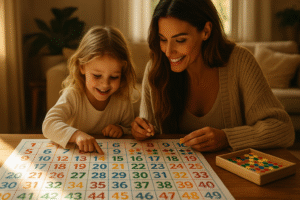7 Easy Car Math Activities for Kids That Supercharge Number Sense (Ages 4–10)

“Are we there yet?” The familiar whine started just five minutes into our drive to grandma’s house. My 7-year-old was already restless, and my 4-year-old was gearing up for her usual car seat protests. But instead of reaching for a tablet, I pulled out something better — car math activities for kids.
As a former math teacher and now a mom, I’ve learned that some of the most powerful math lessons don’t happen in classrooms — they happen in motion. And what better setting than a car? That day, our two-hour drive transformed into a hands-on learning adventure, thanks to simple yet impactful car math activities for kids designed to build number sense, improve focus, and keep little minds curious.
What started as a desperate attempt to avoid backseat meltdowns turned into one of our most enriching learning moments. I realized that the car offers a built-in environment for learning: numbers on license plates, math hidden in mile markers, time on the dashboard, even subtraction at the gas pump. The opportunities are endless.
Today, I’m excited to share seven of our favorite car math activities for kids — the same ones that have turned our road trips and school runs into meaningful learning experiences. These quick, engaging strategies help boost number confidence and attention span without ever opening a workbook. They’re perfect for busy parents looking to sneak math into everyday life — all while keeping kids happy and entertained on the go.

1. License Plate Car Math Activities for Kids
License plates are mathematical goldmines just waiting to be discovered by curious young minds. These portable number puzzles provide endless opportunities for developing number recognition, comparison skills, and basic arithmetic operations while keeping kids engaged during any length of car ride.
I start simple with my 4-year-old by asking her to spot specific numbers on passing license plates. “Can you find a license plate with the number 7?” Once she masters single-digit recognition, we progress to two-digit numbers and eventually complete sequences. For my first-grader, I increase the challenge by asking him to find the largest or smallest number on any plate we pass.
The real magic happens when we turn license plates into mini math problems. I might say, “I see a plate with 3, 8, and 2. Can you add those numbers together?” or “That plate has 4 and 6. What’s the difference between those numbers?” These spontaneous car math activities for kids feel more like games than drills, making the learning stick naturally.
We also play “License Plate Bingo” where each child looks for plates containing numbers that follow specific patterns – odd numbers only, even numbers, or numbers that add up to 10. This activity develops pattern recognition skills while keeping both kids actively scanning and thinking mathematically about everything they observe.
Teacher Mom Tip: Keep a small notebook to track which number combinations your kids struggle with most. This gives you insight into specific skills that need more practice and helps you create targeted challenges during future car rides.
2. Mile Marker Car Math Adventures for Kids
Mile markers transform any highway into a giant number line that stretches across the landscape — a visual anchor for developing number sequences, counting patterns, and basic math concepts through real-world context.
We use mile markers to practice skip counting in various increments. Starting with counting by ones as we pass each marker, we progress to counting by twos, fives, and tens. My 7-year-old particularly enjoys the challenge of counting backwards, which builds subtraction fluency.
Distance calculations become conversation starters. “We’re at mile marker 45, and we need to get to 78. How many more miles?” These types of car math activities for kids show math in motion, helping children internalize that math is not just a school subject — it’s a life skill.
We also discuss elapsed time using markers. “It took us 15 minutes to go from mile 20 to mile 35. How many miles did we travel?” This real-world data builds connections between time, distance, and speed.
Teacher Mom Tip: Use mile markers to talk about halfway points. “What’s halfway between mile 12 and mile 22?” It’s a simple but powerful way to introduce division and fractions visually.
3. Real-World Time & Speed Car Math Activities for Kids
Few environments teach time and speed as naturally as a moving vehicle. From clocks to speed limits to distance signs, the car becomes an interactive learning lab.
We start our trip by checking the clock. “We left at 2:30, now it’s 3:15. How long have we been driving?” These questions build time-telling fluency while making the concept meaningful. As the trip continues, we compare our estimated arrival times with real-time progress.
Speed limit signs help introduce the concept of rate. “The speed limit just dropped from 55 to 35. Are we going faster or slower now?” These subtle observations are excellent car math activities for kids that open doors to discussions on rates and ratios.
Older children can calculate average speed. Younger ones help count stoplights or predict how long until we get to a rest stop. These games build number sense and make travel time fly by.
Teacher Mom Tip: Keep a simple travel log where kids write their time predictions and compare them with actual results. It builds awareness and pride in their growing skills.
4. Gas Station Money Car Math Activities for Kids
Gas stations offer real-world chances to introduce money, decimals, and budgeting — and kids love being part of these decisions.
We talk about the price per gallon and total cost. “If gas is $3.45 a gallon and we get 10 gallons, how much will it be?” These car math activities for kids give money meaning — they see value, not just numbers.
Inside the store, we give spending challenges: “We have $10. Can you get snacks for under that amount?” These moments teach subtraction, comparison, and real-world decision-making.
We even analyze receipts together — checking if totals are correct and looking at tax. These are life skills disguised as everyday math.
Teacher Mom Tip: Carry play coins or real money for younger kids to practice. Let them count the change, sort coins, or act as the “cashier.”
5. Pattern Recognition through Car Math Activities for Kids
Patterns are the heart of math. From traffic lights to highway signs, there are patterns everywhere if you look for them.
“Red, green, yellow — what’s next?” We start by naming light sequences. Then we observe construction zones: “Every third car merges. If we’re the sixth car, when is it our turn?”
We also predict which vehicle type comes next: “We’ve seen 3 trucks, 2 vans… What might be next?” These playful pattern games are powerful car math activities for kids that foster reasoning and prediction skills.
Teacher Mom Tip: Use a small whiteboard to draw traffic sequences. Ask your child to finish the pattern. It’s interactive and helps visual learners stay engaged.
“Transform Every Mile with Car Math Activities for Kids”
After months of using these car math activities for kids, I’ve seen incredible growth in my children’s confidence, problem-solving abilities, and love for numbers. More importantly, screen time battles have turned into joyful, math-filled bonding moments.
These activities don’t require prep or printables. Whether it’s a road trip or a 10-minute commute, the car is a rich learning environment filled with numbers, patterns, time, and opportunity.
When my 4-year-old proudly exclaimed, “That was the funnest car ride ever! Can we do more number games next time?” — I knew we were on the right track.
Sometimes the best math classroom isn’t behind a desk — it’s in a car, on a highway, moving toward something wonderful.
Related Posts You Might Like

Why Estimation Is the Most Important Math Skill You’re Not Teaching
Why Estimation Is the Most Important Math Skill You’re Not Teaching Estimation is the math superpower your child might be

Boost Early Math Skills Through Music | Fun and Proven Learning Strategies for Kids
Boost Early Math Skills Through Music | Fun and Proven Learning Strategies for Kids “Can we sing the counting song

Counting Made Fun: Use Sticker Charts to Teach Early Math at Home
Counting Made Fun: Use Sticker Charts to Teach Early Math at Home “I don’t want to count anymore!” My four-year-old’s
*Also read:
25 Brilliant LEGO Math Activities to Build Number Sense and STEM Skills at Home
Teach Kids to Tell Time: The Clock Game Every Parent Should Try at Home

